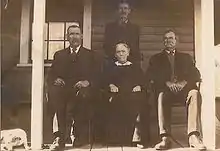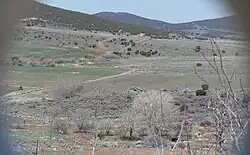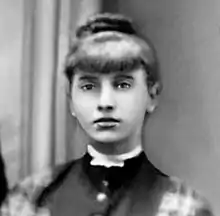Baker–Fancher party
The Baker–Fancher party (also called the Fancher–Baker party, Fancher party, or Baker's Company) was a group of American western emigrants from Marion, Crawford, Carroll, and Johnson counties in Arkansas, who departed Carroll County in April 1857 and "were attacked by the Mormons near the rim of the Great Basin, and about fifty miles from Cedar City, in Utah Territory, and that all of the emigrants, with the exception of 17 children, were then and there massacred and murdered"[1] in the Mountain Meadows massacre. Sources estimate that between 120 and 140 men, women and children were killed on September 11, 1857, at Mountain Meadows, a rest stop on the Old Spanish Trail, in the Utah Territory. Some children of up to six years old were taken in by the Mormon families in Southern Utah, presumably because they had been judged to be too young to tell others about the massacre.[2]
.png.webp)
Background

The Baker–Fancher party consisted of several smaller parties that set out separately from the Ozarks in northwestern Arkansas, and then joined up along the way. Many of the families in the group were prosperous farmers and cattlemen with ample financial resources to make the journey west. Some of the groups had family and friends in California awaiting their arrival, as well as many relatives remaining in Arkansas. Among the groups were the Baker train, led by Captain John Twitty Baker from Carroll County, and the Fancher train, led by seasoned expeditioner Alexander Fancher,[3] which left from Benton County. Other groups included the Huff train, which also left from Benton, the Mitchell, Dunlapp, and Prewitt trains which left from Marion County, and the Poteet–Tackitt–Jones, Cameron, and Miller trains which left from Johnson County. Pleasant Tackitt, from the Poteet–Tackitt–Jones train, was a Methodist minister who led the others in worship and prayer services while on their journey. When the groups left Arkansas in April 1857, the total company numbered more than 200.[4] However, during the journey, some groups split off and others joined. Some of the trains that joined the company may have been from other states, such as Missouri.[5]
The party was well outfitted with wagons, traveling carriages, a large herd of cattle estimated at close to 1,000 head, oxen, as well as numerous horses. They joined the expedition for various reasons; some to settle permanently in California, some to drive cattle west for profit, and some to find California gold. Like other emigrant groups traveling to California, they took money with them and planned to replenish their supplies in Salt Lake City for the remainder of the trip.[6] The actual date of arrival in Salt Lake City is unknown, but historian Juanita Brooks places the arrival as August 3 or August 4, 1857 based on reports in the Journal History of the LDS Church.[7] The Arkansans arrived in Utah with over 800 head of cattle and were low on supplies when they reached the Salt Lake area, a major resupply destination for overland emigrants.
Emigrants associated with the Baker–Fancher Party
Families leaving before reaching Utah Territory
As the different wagon parties traveled across the plains, some of those left by the wayside, ended up traveling to other destinations in safety. If Missourians had ever been these trains' fellow travelers,[8][9] none are known to share these Arkansans' fate. The following is a list of those known to have separated themselves before arriving in the Utah Territory:
- Smith
- Morton
- Hudson
- Basham
- Haydon
- Reed
- Stevenson
- Hamilton
- Farmer
- Lafoon and/or Laffoon
- Poteet – cousins to the Tackitt family (left and went to Texas the day before the massacre)
(Various other Arkansas trains are believed to have been associated with the Fancher–Baker party while on their journeys westward, yet they did not perish with them, include the Crooked Creek, Campbell, Parker, and [John S.] Baker – as distinct from the [John Twitty] Baker – trains.)

Families leaving in Utah Territory
The following is a list of those believed to have separated from the Fancher–Baker party, while it was passing through the Utah Territory:
- Eaton, William M.
- Edwards, Silas
- Rush, Milum L., 28
- Stallcup, Charles, 25
- The John R. Page Family
Members of the wagon train who were at Mountain Meadows
The following table contains a list of those believed to have been killed during the massacre, along with the survivors (who are listed in bold). The table also lists if the person was listed on the 1955 Monument in Harrison, Arkansas, or on the 1990 Monument in Mountain Meadows.
| Members of the wagon train who were at Mountain Meadows | ||||
|---|---|---|---|---|
| Name (alphabetically by surname) | Age at time of massacre | Listed on | ||
| 1955 Monument | 1990 Monument | |||
| Aden, | William Allen | 19 | Yes | Yes |
| Baker, | George W. | 27 | Yes | Yes |
| Manerva Ann Beller | 25 | Yes | Yes | |
| Mary Lovina | 7 | Yes | Yes | |
| Martha Elizabeth | 5 | Yes | Yes | |
| Sarah Frances | 2 | Yes | Yes | |
| William Twitty | 9 months | Yes | Yes | |
| Baker, | John Twitty | 52 | Yes | Yes |
| Abel | 19 | Yes | Yes | |
| Beach, | John | 21 | No | Yes |
| Beller, | David W. | 12 | Yes | Yes |
| Beller, | Melissa Ann | 14 | Yes | Yes |
| Cameron, | William | 51 | Yes | Yes |
| Martha | 51 | Yes | Yes | |
| Tillman | 24 | No | Yes | |
| Isom | 18 | No | Yes | |
| Henry | 16 | No | Yes | |
| James | 14 | No | Yes | |
| Larkin | 8 | No | Yes | |
| Cameron, | Nancy | 12 | No | Yes |
| Coker, | Edward | 27 | No | No |
| Charity Porter | 37 | No | No | |
| Unknown | Child | No | No | |
| Unknown | Child | No | No | |
| Cooper, | William E. | 29 | No | No |
| Abbey | 29 | No | No | |
| Deshazo, | Allen P. | 22 | Yes | Yes |
| Dunlap, | Jesse, Jr. | 39 | Yes | Yes |
| Mary Wharton | 39 | Yes | Yes | |
| Ellender | 18 | No | Yes | |
| Nancy M. | 16 | No | Yes | |
| James D. | 14 | No | Yes | |
| Lucinda | 12 | No | Yes | |
| Susannah | 12 | No | Yes | |
| Margarette | 11 | No | Yes | |
| Mary Ann | 9 | No | Yes | |
| Rebecca Jane | 6 | Yes | Yes | |
| Louisa | 4 | Yes | Yes | |
| Sarah Elizabeth | 1 | Yes | Yes | |
| Dunlap, | Lorenzo Dow | 42 | Yes | Yes |
| Nancy Wharton | 42 | No | Yes | |
| Thomas J. | 18 | No | Yes | |
| John H. | 16 | No | Yes | |
| Mary Ann | 13 | No | Yes | |
| Talitha Emaline | 11 | No | Yes | |
| Nancy | 9 | No | Yes | |
| America Jane | 7 | No | Yes | |
| Prudence Angeline | 5 | Yes | Yes | |
| Georgia Ann | 18 months | Yes | Yes | |
| Eaton, | William M. | Adult | Yes | Yes |
| Edwards, | Silas | Unknown | No | Yes |
| Fancher, | Alexander | 45 | Yes | Yes |
| Eliza Ingram | 33 | Yes | Yes | |
| Hampton | 19 | Yes | Yes | |
| William | 17 | Yes | Yes | |
| Mary | 15 | Yes | Yes | |
| Thomas | 14 | Yes | Yes | |
| Martha | 10 | Yes | Yes | |
| Margaret A. | 8 | Yes | Yes | |
| Sarah G. | 8 | Yes | Yes | |
| Christopher "Kit" Carson | 5 | Yes | Yes | |
| Triphenia | 22 months | Yes | Yes | |
| Fancher, | James Mathew | 25 | Yes | Yes |
| Fancher, | Frances "Fanny" Fulfer | Unknown | No | Yes |
| Fancher, | Robert | 19 | Yes | Yes |
| Gresley, | John | 21 | No | No |
| Hamilton, | Unknown | Unknown | Yes | Yes |
| Huff, | Saladia Ann Brown | 38 | Yes | Yes |
| John | 14 | No | Yes | |
| William C. | 13 | No | Yes | |
| Mary E. | 11 | No | No | |
| James K. | 8 | No | Yes | |
| Nancy Saphrona | 4 | Yes | Yes | |
| Unknown Son | Unknown | No | No | |
| Jones, | John Milum | 32 | Yes | Yes |
| Eloah Angeline Tackitt | 26 | Yes | Yes | |
| Unknown | Unknown | Yes | Yes | |
| Felix Marion | 18 months | Yes | Yes | |
| Jones, | Newton | 23 | No | Yes |
| McEntire, | Lawson A. | 21 | Yes | Yes |
| Miller, | Josiah (Joseph) | 30 | Yes | Yes |
| Matilda Cameron | 26 | Yes | Yes | |
| James William | 9 | No | Yes | |
| John Calvin | 6 | Yes | Yes | |
| Mary | 4 | Yes | Yes | |
| Joseph | 1 | Yes | Yes | |
| Mitchell, | Charles R. | 25 | Yes | Yes |
| Sarah C. Baker | 21 | Yes | Yes | |
| John | Infant | Yes | Yes | |
| Mitchell, | Joel D. | 23 | Yes | Yes |
| Prewit, | John | 20 | Yes | Yes |
| Prewit, | William | 18 | Yes | Yes |
| Rush, | Milum Lafayette | 29 | Yes | Yes |
| Tackitt, | Cyntha | 49 | Yes | Yes |
| William H. | 23 | Yes | No | |
| Marion | 23 | Yes | Yes | |
| Sebron | 18 | No | Yes | |
| Matilda | 16 | No | Yes | |
| James M. | 14 | No | Yes | |
| Jones M. | 12 | No | Yes | |
| Tackitt, | Pleasant | 25 | Yes | Yes |
| Tackitt, | Armilda Miller | 22 | Yes | Yes |
| Emberson Milum | 4 | Yes | Yes | |
| William Henry | 19 months | Yes | Yes | |
| Wilson, | Richard | 27 | Yes | Yes |
| Wood, | Solomon R. | 20 | Yes | Yes |
| Wood, | William Edward | 26 | Yes | Yes |
Siege and massacre
During the early morning hours of Monday, September 7,[10] the Baker–Fancher party was attacked, at their Mountain Meadows camp, by as many or more than 200 fighters – Mormon militiamen disguised as Native Americans, and according to some accounts including Paiutes,[11] but this was refuted by some of the survivors.
The attackers were positioned in a small ravine southeast of the emigrant camp.[12] As the attackers shot into the camp, the Baker–Fancher party defended itself by encircling and lowering their wagons, along with digging shallow trenches and throwing dirt both below and into the wagons. Seven emigrants were killed during this opening attack and were buried somewhere within the wagon encirclement; sixteen more were wounded. The attack continued for five days, during which the besieged families had little or no access to fresh water and their ammunition was depleted.[13]
On Friday, September 11, 1857, two Mormon militiamen approached the Baker–Fancher party wagons with a white flag and were soon followed by Indian agent and militia officer John D. Lee. Lee told the battle-weary emigrants that he had negotiated a truce with the Paiutes, whereby they could be escorted safely the 36 miles back to Cedar City under Mormon protection in exchange for turning all of their livestock and supplies over to the Native Americans.[14] Accepting this, the emigrants were led out of their fortification. When a signal was given, the Mormon militiamen turned and murdered the male members of the Baker–Fancher party standing by their side. According to Mormon sources, the militia let a group of Paiute Indians execute the women and children. Some children were killed while in their mothers' arms or after being crushed by the butts of rifles or boot heels. The bodies of the dead were gathered and looted for valuables, and were then left in shallow graves or on the open ground. Members of the Mormon militia were sworn to secrecy. A plan was set to blame the massacre on the Indians. The militia did not kill 17 small children who were deemed too young to relate the story. These children were taken in by local Mormon families. The children were later reclaimed by the U.S. Army and returned to relatives, and there is legend that one girl was not returned and lived out her life among the Mormons.[15]

Leonard J. Arrington reports that Brigham Young received a rider at his office on the same day of the massacre. This letter asked Young's opinion on what to do with the Baker–Fancher party. When he learned what was contemplated by the members of the LDS Church in Parowan and Cedar City, he sent back a letter that the Baker–Fancher party be allowed to pass through the territory unmolested.[16][17] Young's letter supposedly arrived two days too late, on September 13, 1857. However Jon Krakauer claims that Brigham Young and other Utah territory officials encouraged the massacre beforehand and sought to deny their roles afterward.[18]
Some of the property of the dead was reportedly taken by the Native Americans involved, while large amounts of cattle and personal property was taken by the Mormons in Southern Utah. John D. Lee took charge of the livestock and other property that had been collected at the Mormon settlement at Pinto. Some of the cattle was taken to Salt Lake City and traded for boots. Some reportedly remained in the hands of John D. Lee. The remaining personal property of the Baker–Fancher party was taken to the tithing house at Cedar City and auctioned off to local Mormons.[19] Brigham Young, appalled at what had taken place, initially ordered an investigation into the massacre but in the end it must be acknowledged that his own unwillingness to work with Federal authorities contributed both directly and indirectly to the blunder of justice, and was part of the reason two trials were necessary.[16]
Family legends
Several histories and legends have been passed down from the surviving children, the oldest of whom was only 6 years of age during the massacre, to today's descendants; some of these stories tell a slightly different tale of the massacre.
In 2007, the families/descendants of the surviving children came together in Utah, for the 150th anniversary of the massacre. The family stories were compared and found to be very similar. All of the families agree the stories told of Mormons dressed as Natives, and that none of the Native people participated in the Massacre of the wagon train. Family stories tell of being taken by "Indians who washed of their skin and turned white".
Surviving children

Seventeen small children, all under the age of seven, survived the Mountain Meadows massacre. Two years after the Massacre, the orphans were returned to their families. The following is a list of the surviving children:
- Baker, Mary Elizabeth, 5
- Baker, Sarah Frances, 3
- Baker, William Twitty, 9 months
- Dunlap, Georgia Ann, 18 months
- Dunlap, Louisa, 4
- Dunlap, Prudence Angeline, 5
- Dunlap, Rebecca J., 6
- Dunlap, Sarah E., 1
- Fancher, Christopher "Kit" Carson, 5
- Fancher, Triphenia D., 22 months
- Huff, Nancy Saphrona, 4 (Huff is prominently featured in the documentary Burying the Past: Legacy of the Mountain Meadows Massacre)
- Jones, Felix Marion, 18 months
- Miller, John Calvin, 6
- Miller, Joseph, 1
- Miller, Mary, 4
- Tackitt, Emberson Milum, 4 (Returned to their mother's family, the Millers)
- Tackitt, William Henry, 19 months (Returned to their mother's family, the Millers)
Aftermath
Following the massacre, the perpetrators swore each other to secrecy, and the murdered members of the wagon train were hastily buried; yet the elements and scavengers quickly uncovered their corpses. Two years after the massacre, United States Army officer James Henry Carleton was sent to investigate it. He was convinced that the Mormons were the main perpetrators. Some of these children, who had seen their families killed, recalled seeing white men dressed as Indians among the attackers. Carleton examined the scene of the massacre and believed that the Paiutes had played a minimal role, and that the attack had been planned and executed by the Mormons. The remains of about thirty-four people were found and buried. The troops then built a cairn over the graves, and made a large cross from local cedar trees, the transverse beam bearing the engraving, "Vengeance Is Mine, Saith The Lord: I Will Repay". This cross was placed at the top of cairn and a large slab of granite was leaned upon the side, with the engraving:
Here 120 men, women, and children were massacred in cold blood early in September, 1857. They were from Arkansas.[21]
Some claim that, in 1861, Young brought an entourage to Mountain Meadows and had the cairn and cross destroyed, while exclaiming, "Vengeance is mine and I have taken a little".[22]
Notes
- Uncle Dale's Old Mormon Articles: Misc. Southern States, 1845–1919
- Bagley 2002, p. 209
- Finck 2005 Fancher had journeyed to California from Arkansas previously in 1850 and 1853. Bagley 2002; the 1850 San Diego County, Calif. census Roll: M432_35; Page: 280; Image: 544.)
- Bagley 2002, pp. 55–68; Stenhouse 1873, pp. 424–427
- Bancroft 1889, p. 512; Gibbs 1910, p. 12
- Stenhouse 1873, p. 428
- Brooks 1950, pp. 28–29
- Bancroft 1889.
- Gibbs 1910.
- Brooks 1950, p. 50; Bigler 1998, p. 169
- Lee 1877, pp. 226–227 Lee said the first attack occurred on a Tuesday and the Native Americans were several hundred strong.
- Walker, Turley & Leonard 2008, p. 158
- Shirts 1994
- Shirts, (1994) Paragraph 9
- Brooks, 1950, pp. 101–105
- Leonard Arrington. (1986) Brigham Young: American Moses, p. 257
- Brigham Young to Isaac C. Haight, Sept. 10, 1857, Letterpress Copybook 3:827–28, Brigham Young Office Files, LDS Church Archives
- Krakauer, Jon (1999), "Chapter 18", Under the Banner of Heaven, New York: Anchor Books, ISBN 1-4000-3280-6
- Brooks, 1950. See also Klingensmith Testimony at first trial of John D. Lee
- Nancy Saphrona Huff at Burying the Past: Legacy of the Mountain Meadows Massacre website
- Carleton, James H. (1902), Special Report of the Mountain Meadows Massacre, Government Printing Office, p. 15
- Sally Denton (2003). American Massacre: The Tragedy at Mountain Meadows, September 1857 (New York: Vintage Books, ISBN 0-375-72636-5) p. 210.
References
- Bagley, Will (2002), Blood of the Prophets: Brigham Young and the Massacre at Mountain Meadows, Norman, Oklahoma: University of Oklahoma Press, ISBN 0-8061-3426-7
- Bancroft, Hubert Howe (1889), The Works of Hubert Howe Bancroft: History of Utah, 1540–1886, vol. 26, San Francisco: History Company, LCCN 07018413, LCC F826.B2 1889 (Internet Archive versions)
- Bigler, David (1998), Forgotten Kingdom: The Mormon Theocracy in the American West, 1847–1896, Logan, Utah: Utah State University Press, ISBN 0-87421-245-6
- Briggs, Robert H. (2006). "The Mountain Meadows Massacre: An Analytical Narrative Based on Participant Confessions". Utah Historical Quarterly. 74 (4): 313–333. doi:10.2307/45062984. JSTOR 45062984. S2CID 254444678. Archived from the original (PDF) on 2013-10-21. Retrieved 2011-03-30.
- Brooks, Juanita (1950), The Mountain Meadows Massacre, Norman, Oklahoma: University of Oklahoma Press, ISBN 0-8061-2318-4
- Burns, Ken; Ives, Stephen (1996). "New Perspectives on the West (Documentary)". Washington, D.C.: PBS.
- Finck, James (2005), "Mountain Meadows Massacre", in Dillard, Tom W. (ed.), Encyclopedia of Arkansas History & Culture, Little Rock, Arkansas: Encyclopedia of Arkansas Project
- Forney, J. (5 May 1859). "Kirk Anderson Esq". Valley Tan (published 10 May 1859). p. 1. Archived from the original on 12 December 2012. Retrieved 1 June 2019.
- Gibbs, Josiah F. (1910), The Mountain Meadows Massacre, Salt Lake City: Salt Lake Tribune, LCCN 37010372, LCC F826 .G532
- Little, James A. (1881). "Jacob Hamblin: A Narrative of His Personal Experience". Faith Promoting Series. Vol. 5.
- Lee, John D. (1877), Bishop, William W. (ed.), Mormonism Unveiled; or the Life and Confessions of the Late Mormon Bishop, John D. Lee, St. Louis, Missouri: Bryan, Brand & Co., ISBN 1-4366-1518-6
- Rogers, Wm. H. (February 29, 1860). "The Mountain Meadows Massacre". Valley Tan. pp. 2–3. Archived from the original on December 15, 2012.
- Shirts, Morris (1994), "Mountain Meadows Massacre", in Powell, Allen Kent (ed.), Utah History Encyclopedia, Salt Lake City: University of Utah Press, ISBN 0874804256, OCLC 30473917, archived from the original on 2013-08-09, retrieved 2013-10-31
- Stenhouse, T.B.H. (1873), The Rocky Mountain Saints: a Full and Complete History of the Mormons, from the First Vision of Joseph Smith to the Last Courtship of Brigham Young, New York: D. Appleton, ASIN B00085RMQM, LCCN 16024014, LCC BX8611 .S8 1873
- Thompson, Jacob (1860). "Message of the President of the United States: communicating, in compliance with a resolution of the Senate, information in relation to the massacre at Mountain Meadows, and other massacres in Utah Territory, 36th Congress, 1st Session, Exec. Doc. No. 42". Washington, D.C.: U.S. Dept. of the Interior.
- Turley, Richard E., Jr. (September 2007). "The Mountain Meadows Massacre". Ensign. Salt Lake City: LDS Church. ISSN 0884-1136.
{{cite journal}}: CS1 maint: multiple names: authors list (link) - Walker, Ronald W.; Turley, Richard E., Jr.; Leonard, Glen M. (2008), Massacre at Mountain Meadows, Oxford University Press
{{citation}}: CS1 maint: multiple names: authors list (link) - Young, Brigham (August 5, 1857a). "Proclamation by the Governor". Salt Lake City: Utah Territory.